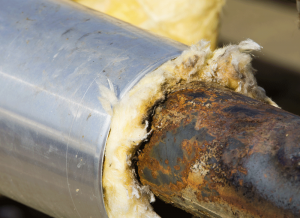Stress corrosion cracking is a hot topic in the insulation industry these days, and rightfully so. The damage caused by corrosion failure can be catastrophic. It is crucial for industry professionals and product specifiers to recognize the inherent risk involved with corrosion under insulation (CUI) and learn how we go about testing insulation to determine whether or not it contributes to CUI.
Corrosion can happen anywhere metal, water and oxygen are present, but it is far more likely to happen when all five of the following factors are combined:
- Liquid water
- Oxygen
- Operating temperatures between 100°F and 350°F
- Corrosive chemical compounds
- Acidic pH: less than 7
Most pipe systems are at risk during shut downs and MRO projects when normally high operating temperatures drop into the CUI realm (100°F-350°F). In this temperature range, any moisture that has infiltrated the system remains trapped beneath the insulation until the pipe becomes hot enough to vaporize it. The stretch of time between getting wet and drying out becomes the CUI danger zone.
For this reason, once water penetrates the system, the insulation’s corrosion inhibiting properties become essential.
To determine how insulations will perform under these conditions, they are tested using the ASTM C1617 test method (Standard Practice for Quantitative Accelerated Laboratory Evaluation of Extraction Solutions Containing Ions Leached from Thermal Insulation on Aqueous Corrosion of Materials). This test is a four-day process that begins by grinding the insulation into a fine powder and extracting it with boiling water. This powder/water solution is then slowly pumped onto a hot, carbon-steel coupon, which vaporizes the water and leaves the insulation extract in its wake.
Throughout the four days, the coupon goes through hundreds of wet/dry cycles, generating the perfect storm of conditions to create measurable and visual corrosion over a very short period of time. When the test is complete, the scale and rust are cleaned off the coupons, and the coupons are then weighed to determine how much weight they lost as a result of the corrosion. The figure is determined in mils per year and is called the mass loss corrosion rate (MLCR).

Passing standards for the ASTM C1617 test method vary from product to product. For example, in order for silica aerogel to pass ASTM C1617, the standard indicates that it must have a lower MLCR than a 5 ppm chloride solution. In contrast, Thermo-12 Gold calcium silicate insulation with the XOX active corrosion inhibiting formula must be less corrosive than deionized water, which has a chloride content of approximately 0 ppm. This requirement makes the Thermo-12 Gold ASTM C1617 pass criterion notably more stringent and Thermo-12 Gold product significantly less corrosive than silica aerogel.
Thermo-12 Gold is unique in that water actually triggers the XOX formula into action. When water infiltrates the system, the XOX formula actively uses it to travel to the pipe surface; from there, it creates a protective coating over the pipe that prevents the water from making contact. As the pipe heats up, the coating gets stronger and more resilient. The XOX formula also actively neutralizes corrosive chemicals helping to raise the pH.
With other insulations that have a higher MLCR, the only means of protection against CUI when water enters the system is to ensure the pipe is hot enough to vaporize the water before it reaches the pipe surface. Naturally, this approach is both unreliable and potentially dangerous.
ASTM C1617 offers valuable data points to determine how effective various insulations will be when it comes to preventing CUI. But the important thing to remember is that even though two insulations may have received passing grades under ASTM C1617, they may not offer equal CUI performance because some pass criteria are more stringent than others. Also, before you specify any insulation, make sure you fully understand the nature and scope of its CUI performance and whether it has active corrosion-inhibiting properties than can deliver higher CUI performance.
